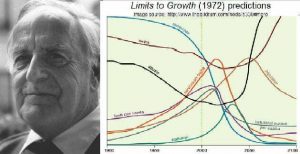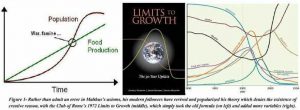The Club of Rome and the Rise of the “Predictive Modelling” Mafia (2)
Read the first part of the article
The 1001 Nature Trust
In order to finance this paradigm shift, the 1001 Nature Trust was founded in 1970 by Prince Bernhard of the Netherlands.
Bernhard (founder of the Bilderberg Group in 1954) had worked alongside his close misanthropic associates Prince Philip Mountbatten and Sir Julian Huxley to create the World Wildlife Fund (WWF) in 1961. The WWF was itself created to raise funds for the previously created International Union for the Conservation of Nature (IUCN), which was founded by Sir Julian Huxley in 1947. Huxley had been a busy bee, having established UNESCO the year prior with a mandate to revive eugenics and promote world government under new names. When he co-founded the WWF, Huxley was also acting President of the British Eugenics Society.

The plan was simple: each of the 1001 founding members simply put $10,000 into the trust which was then directed towards the green paradigm shift that sought to replace the old paradigm of “saving humanity from empire” towards the new paradigm of “saving nature from humanity” as outlined by Sir King above.
Prominent 1001 Nature Trust members included international royalty, billionaires, and technocratic sociopaths who wanted nothing more than to manage this promised Brave New World as part of the “alpha” caste.
Many of these figures were simultaneously founding members of the Club of Rome, including Canada’s Maurice Strong, who later became Vice President of the WWF under Prince Philip’s presidency.
When Strong became WWF Vice President in 1978, the man he replaced was Maj. Gen. Louis Mortimer Bloomfield. Bloomfield was another 1001 Club founding member whom New Orleans District Attorney Jim Garrison discovered to be implicated in the Montreal-based assassination of the anti-Malthusian President John F. Kennedy in 1963 via his involvement with Permindex. This same Swiss-based organization served as a cover for various Gladio-connected assassinations including several efforts to kill JFK ally Charles de Gaulle, resulting in that organization’s expulsion from France soon thereafter.
A Word on Maurice Strong
One of Prince Bernhard and Prince Philip’s most powerful “ally” was a man named Maurice Strong, a 1001 Trust founding member who also “happened” to co-found the World Economic Forum and served as WWF vice-president under Philip from 1976-78. In a 1990 interview with West Magazine, Strong let the cat out of the bag, asking rhetorically:
“What if a small group of world leaders were to conclude that the principal risk to the Earth comes from the actions of the rich countries? And if the world is to survive, those rich countries would have to sign an agreement reducing their impact on the environment. Will they do it? The group’s conclusion is ‘no’. The rich countries won’t do it. They won’t transform. So, in order to save the planet, the group decides: Isn’t the only hope for the planet that the industrialized civilizations collapse? Isn’t it our responsibility to bring that about?”
It is important to recall that Maurice Strong’s remarks occurred in the context of a “fictional book” he wished to write that would take place at the World Economic Forum – a group he and Kissinger led in co-founding 20 years earlier using a German cardboard cut out named Klaus Schwab. In 2015, Klaus eulogized Strong by calling him “my mentor.”
While some apologists dismiss the sociopath’s remarks as simple musings over a work of fiction, it is worth considering what Maurice himself announced at the keynote address to the 1992 UN Conference on Population and the Environment in Rio De Janeiro. Strong had been tapped to head this second Earth Summit (the first having been the 1972 Stockholm Conference on the Human Environment which he also chaired). At this 1992 summit, Strong said:
“Industrialized countries have developed and benefited from the unsustainable patterns of production and consumption which have produced our present dilemma. It is clear that current lifestyles and consumption patterns of the affluent middle class, involving high meat intake, consumption of large amounts of frozen and convenience foods, use of fossil fuels, appliances, home and work-place air-conditioning, and suburban housing- are not sustainable. A shift is necessary toward lifestyles less geared to environmentally damaging consumption patterns.”
The Rio Summit had established a new era in the consolidation of NGOs and corporations under the “green” agenda. This doctrine was formalized with Agenda 21 (later renamed Agenda 2030) and the Earth Charter, co-authored by Mikhail Gorbachev, Jim MacNeill and Strong between 1996-2000. The International Earth Charter drafting Committee was chaired by none-other than transhumanist billionaire Steven Rockefeller.
According to the World Economic Forum’s own website, Prince Bernhard was the primary patron of the infamous 1973 WEF Summit that announced the Davos Manifesto for the first time, laying the groundwork for the theory of technocratic feudalism with a loose capitalist veneer known as “Stakeholder Capitalism.” It was also at this 1973 Summit, that the Club of Rome was first introduced to the world scene in order to present a new program for population control.
Limits to Growth
The document which became the bible and blueprint of this new anti-humanist movement that birthed today’s Green New Deal agenda was titled Limits to Growth (1972) and today holds the record as the most widely read book on ecology, having sold 30 million copies published into 32 languages.
A recent article celebrating the book’s 40-year anniversary stated “it helped launch modern environmental computer modeling and began our current globally focused environmental debate. After ‘Limits To Growth’, environmentalists, scientists and policy-makers increasingly thought of ecological problems in planetary terms and as dynamically interconnected. It is worth revisiting ‘Limits’ today because, more than any other book, it introduced the concept of anthropocentric climate change to a mass audience.”
The book itself was the culmination of a two-year study undertaken by a team of MIT statisticians under the nominal heading of Jay Forrester and Dennis Meadows.
Here’s a February 2022 video of Dennis Meadows musing over his hopes that the coming inevitable genocide of 80% of the world population could be accomplished peacefully under a “benevolent” dictatorship.
The MIT study itself did not even begin in the USA, but rather in Montebello Quebec in 1971, when Club of Rome-backer Pierre Trudeau allocated tax payer money to initiate the project. A network of Rhodes Scholars and Privy Councillors centered around Alexander King, Maurice Strong, Maurice Lamontagne (founder of Environment Canada), Marc Lalonde (Rhodes Scholar, Trudeau advisor and head of the Prime Ministers Office), Michael Pitfield (Privy Council Clerk and founder of Canada’s CSIS) and Rhodes Scholar Governor General Roland Michener, among others, had presided over that meeting. When the Canadian funds had served their role, the project continued to receive its funding from the Aurelio Peccei’s Volkswagen Foundation.

The Chaining of Prometheus
A long time, London-trained asset and close collaborator of Canada’s Prime Minister Pierre Trudeau was Maurice Lamontagne, a Club of Rome member and former President of Canada’s Privy Council from 1964-65.
Of all of the Club of Rome’s members, Lamontagne was the most candid in identifying the Earth’s greatest enemy to be human creativity itself. Writing in his Senate Committee Reports of 1968-1972 which reformed science policy funding and planning, Lamontagne wrote:
“Nature imposes definite constraints on technology itself and if man persists in ignoring them the net effect of his action in the long run can be to reduce rather than to increase nature’s potential as a provider of resources and habitable space. But then, an obvious question arises: How can we stop man’s creativeness?”
Correctly recognizing that the yearning to discover the unknown is built into the human condition, Lamontagne answers his own question, writing:
“How can we proclaim a moratorium on technology? It is impossible to destroy existing knowledge; impossible to paralyze man’s inborn desire to learn, to invent and to innovate. In the final analysis we find that technology is merely a tool created by man in pursuit of his infinite aspirations and is not the significant element invading the natural environment. It is material growth itself that is the source of conflict between man and nature.”
Thus, creativity and its fruits of technological progress are acceptable only IF they reduce the assumed conflict between man and nature posited by Lamontagne. “Bad” technology in Lamontagne’s formulation, has the effect of increasing humanity’s material growth (i.e.: powers of productivity). If, on the other hand, we promote technologies of a low energy flux density form, such as windmills, solar panels and biofuels, which reduce the energy available and thus the amount of economic activity in which man can engage, then technology can be defined as “good” according to this twisted logic.
This concept was echoed by another Club of Rome member and collaborator with Lamontagne on his Senate Report named Omond Solandt. Solandt made his career as the science advisor to Lord Louis Mountbatten (Prince Philip’s mentor) during WWII and headed Canada’s Defense Research Board until 1957, where he collaborated on MK Ultra alongside the infamous Ewan Cameron at McGill University. Testifying to the Lamontagne Senate Commission in 1970 Solandt said:
“There is no longer any need to advance science. The need is rather to understand, guide and use science effectively for the welfare of mankind.”
What defines “the welfare of mankind” in the thinking of an MK Ultra proponent should give one chills.
In preparation for the “post-industrial order” that was unleashed with the 1971 floating of the US dollar and the destruction of the Bretton Woods monetary system, Lamontagne prescribed that the “new wisdom” should no longer aim at discoveries in atomic, medical and space sciences, in order to focus on more “practical” engineering endeavors. He also proposed that funding to advanced science be diminished by widening the definition of “science” itself to embrace the humanities, monetary economics and social sciences. Those programs then began absorbing the funding that had formerly been directed to research on pure science. Lamontagne stated this in volume one of his report:
“The new wisdom prescribes that the additional R&D effort be devoted to the life sciences and social sciences rather than the physical sciences to economic and social objectives rather than curiosity and discovery.”
In Defense of Prometheus
One leading Canadian scientist took an early stand against this Club of Rome-driven transformation. Ronald Hayes, professor of environmental science at Dalhousie University and Canadian civil servant wrote his 1973 book The Chaining of Prometheus: The Evolution of a Power Structure for Canadian Science, where he identified Lamontagne as a minion of the deity Zeus as portrayed in Aeschylus’ famous drama Prometheus Bound. The ancient Greek drama told the story of the demi-god Prometheus who was punished for 10,000 years for the defiant act of teaching humanity how to use the fire which Zeus had monopolized for himself.
Attacking the call to deconstruct the entire 1938-1971 science funding structure and rebuild it under a new technocratic regime, Professor Hayes called out the concerted attack on the National Research Council of Canada which had been the driving force of technological progress since WWII saying:
“Lamontagne wants to destroy the National Research Council, the body that has nurtured and launched much of the government research and got the graduate programs going in our universities. It is a fault of the Trudeau administration which Lamontagne echoes.”
Hayes attacked the newly-formed powers of the Treasury Board which were now given exceptional control of science policy under a new scientific dictatorship when he said:
“The most subtle exercise of power, which obviates the necessity of close control, is infiltration by reliable people – the creation of a ruling elite. These Englishmen became known the world over as the rulers of the British Empire. With somewhat similar aims, the Public Service Commission is grooming future Canadian government managers to follow the general policies and precepts of the Treasury Board.”
Predictive Models Take Over Actual Thinking
Although Professor Hayes was right to attack the terrible fraud that was being committed under the helm of Senator Lamontagne’s reform of Canadian science funding in 1973, he neglected the global changes which the Club of Rome’s predictive modelling revolution had set into motion.
The Club of Rome’s 1972 Limits to Growth was the first of its kind to fuse together global temperature with economic variables like population growth, resource loss, and the under-defined category of “pollution”. By utilizing linear equations to extrapolate trends into the future, the Club of Rome had set the stage for two major fallacies:
Fallacy #1 – The fabric of physical space time shaping the discoverable universe is intrinsically non-linear and thus not expressible by any form of linear equations regardless of the computing power involved. Human creative mentation is most explicitly non-linear as it is tied to non-formalizable states of existence like inspiration, love of truth, dignity, and beauty which no binary system can approximate. The Club of Rome programmers ignored these facts and assumed the universe was as binary as their software.
Fallacy #2 – The data sets themselves could easily be skewed and re-framed according to the controllers of the computer programmers who aspired to shape government policy. We have already seen how this technique was used to drive fallacious results of future scenarios under the hand of Imperial College’s Neil Ferguson and the same technique has been applied in ecological modelling as well.

This use of skewed, under-defined statistics, projected into the future in order to “act preventatively on future crises” became a hegemonic practice for the next 40 years and has been used by neo-Malthusians ever since to justify the increased rates of war, poverty and disease across the world.
With the Limits to Growth computer models, a scientific veneer was given to the cultish efforts of fringe neo-Malthusians like Stanford University’s Paul Ehrlich, whose 1968 book The Population Bomb tried to forecast an inevitable global planetary crisis where oil would dry up, arable lands would dry away and resources would disappear by the year 2000. Ehrlich’s cynical thesis won over a cult following but due to its airy generalizations, it didn’t win many converts among policy making or scientific circles. The Club of Rome changed all of that, making Ehrlich’s book a best seller by 1972.
To get a sense of the roots of Ehrlich’s Malthusian outlook, it is worth appreciating his hateful concept of human nature as little more than thoughtless cancer cells growing at geometric rates and slowly killing its host. In his 1968 book, he wrote:
“A cancer is an uncontrolled multiplication of cells; the population explosion is an uncontrolled multiplication of people. We need to shift our efforts from the treatment of the symptoms to the cutting out of the cancer. The operation will demand many apparently brutal and heartless decisions.”
Ehrlich’s protégé John Holdren, who helped lead the shutdown of NASA’s manned space systems and slashed what little remained of an American fusion program as Obama’s science Czar from 2009-2017, added his voice to this new Malthusian priesthood in his 1977 book Ecoscience (co-authored with Ehrlich).
On pg. 942 we find a clear blueprint for a system of green global governance which the duo saw as the only solution to the oncoming population bomb:
“Perhaps those agencies, combined with UNEP and the United Nations population agencies, might eventually be developed into a Planetary Regime – sort of an international superagency for population, resources, and environment. Such a comprehensive Planetary Regime could control the development, administration, conservation, and distribution of all natural resources, renewable or nonrenewable, at least insofar as international implications exist. Thus the Regime could have the power to control pollution not only in the atmosphere and oceans, but also in such freshwater bodies as rivers and lakes that cross international boundaries or that discharge into the oceans. The Regime might also be a logical central agency for regulating all international trade, perhaps including assistance from DCs to LDCs, and including all food on the international market. The Planetary Regime might be given responsibility for determining the optimum population for the world and for each region and for arbitrating various countries’ shares within their regional limits. Control of population size might remain the responsibility of each government, but the Regime would have some power to enforce the agreed limits.”
Under this heartless logic, nation states simply had to be converted into tools for imposing depopulation programs rather than naively endeavoring to end colonialism, poverty and war as John Kennedy, Bobby Kennedy, Charles de Gaulle, Daniel Johnson, Enrico Mattei or Martin Luther King had once attempted.
Read the third part of the article
Author: Matthew Ehret
yogaesoteric
February 1, 2023

Excellent insight!